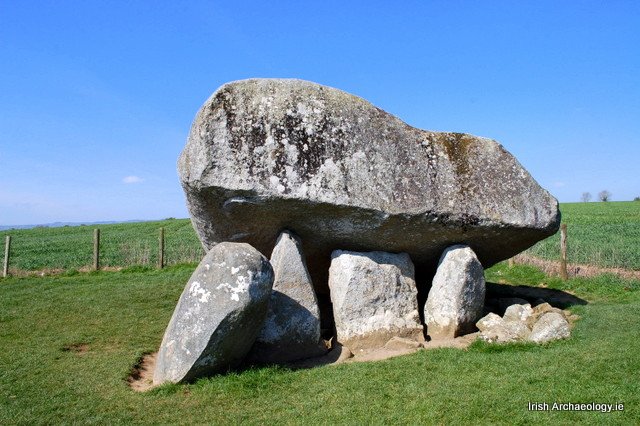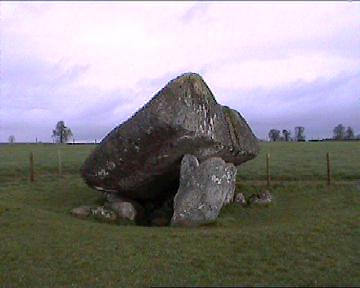

There is very little supporting evidence for this, however sometimes you find a small platform of cairn material around the base of the dolmen, but often there is nothing at all. In the case of dolmens this would mean that the stone frame was only visible because the mound had weathered, or been robbed, away. It has long been assumed that all chambered monuments were encased within a mound or cairn. Carlow (Kernanstown) boasts one of the largest capstones known anywhere in Europe, at a staggering 160 tonnes. Archaeological heavyweight: Brownshill in Co. Was this showboating designed to draw attention to the prowess of those assembling sites like these? To us, this delicate arrangement indicates that the cairn material sometimes found around such monuments served a radically different purpose to the traditional view: these are not the vestiges of a lost burial mound, but packing to keep the uprights in place. The capstones often balance precariously on the tips of the supporting slabs beneath. Carlow (Kernanstown), which at 160 tonnes ranks as one of the largest known anywhere in Europe.īuilding these mighty monuments using prehistoric technology was an incredible feat - something their proud creators were apparently eager to highlight.

But even Garn Turne cannot compare with the absolutely colossal capstone at Brownshill, Co. To put this in perspective, the great sarsen stones at Stonehenge weigh on average 25 tonnes. Weighing in at around 80 tonnes, the Garn Turne Major capstone is a truly massive slab of rock. In order to get a better idea of how these dolmens were engineered, we began a campaign of excavations at Garn Turne Major in Pembrokeshire, home to the largest surviving capstone from a British megalithic monument. So far, so straightforward - except for the small matter of raising the capstone. Yet their composition is very simple: to create a dolmen, you simply place a large slab or ‘capstone’ on top of three or more upright stones, creating an open, box-like chamber. Of all of the kinds of chambered tomb that are found in Britain and Ireland, dolmens are perhaps the most iconic - and the least understood. Overlooking the collapsed remains of the main dolmen - a type of Neolithic chambered tomb - at Garn Turne in Pembrokeshire. Vicki Cummings and Colin Richards investigate how these distinctive monuments were constructed - and what happened when a project did not go to plan. They represent remarkable achievements for their Neolithic builders, crowned with stones weighing as much as 160 tonnes. Well known on the Continent and scattered along the coasts of Wales, Cornwall, and Ireland, dolmens are an immediately recognisable form of chambered tomb. Exploring Neolithic construction at Garn Turne


 0 kommentar(er)
0 kommentar(er)
